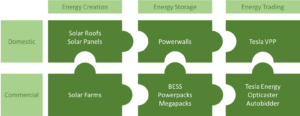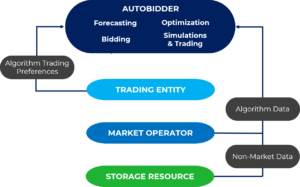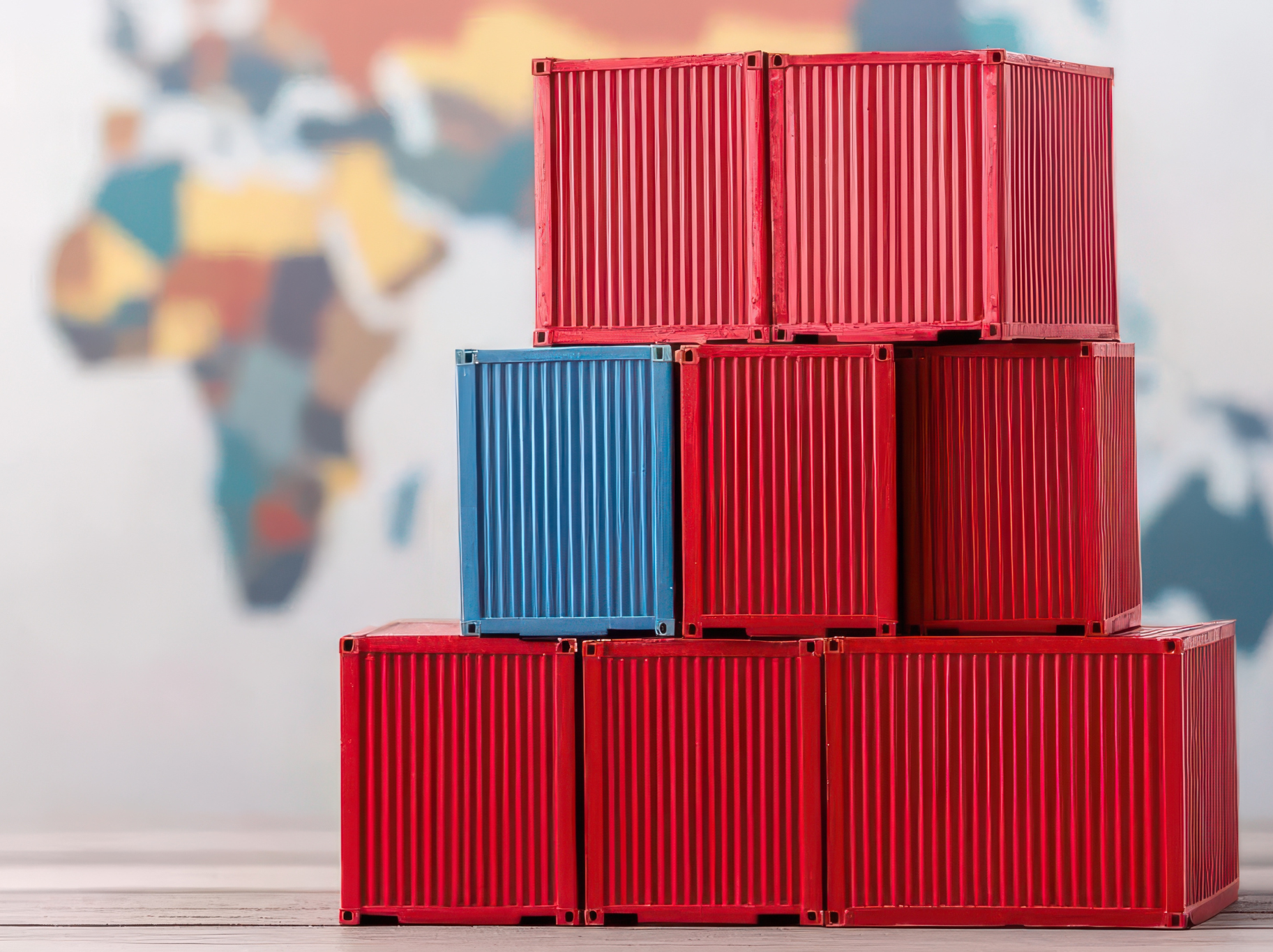Tesla energy strategy: A global trader of green energy
Posted by | Michael Ratcliffe
Tesla energy strategy
In this article, we investigate Tesla Energy’s overall strategy from making renewable solar energy to storing, selling and trading it, encompassing solar energy production, energy storage, and electricity sales and trading. The article highlights Tesla’s integrated approach to the energy market and discusses the progress and challenges faced in each area. The first leg of the strategy is centered on electricity production through solar panels, including the Solar Roof initiative, which has faced some operational and competitive issues. The second leg involves energy storage, with Tesla’s Megapacks gaining momentum and being used to replace conventional power plants and support renewable energy projects. Finally, the third leg focuses on the deployment and sales of electricity, with Tesla’s Virtual Power Plants linking domestic power storage systems into distributed power networks. Without doubt, Tesla has the potential to become a significant player in the renewables value chain, transforming into a major global green distributed energy supplier and disrupting the global energy market as it did in the automotive industry.
Early Tesla energy strategy
When we look at the different areas of the energy market in which Tesla is operating, there is a clear overall integrated strategy although not all components are currently working ideally. Since Elon Musk is used to dealing with performance issues and having to pivot and redesign to get the key products right, we can expect that those areas that are having issues, such as Tesla’s solar roof service, will be reengineered.
The following diagram illustrates Tesla Energy’s playing field. We can see that it is already operating across three key areas of the energy market – production, storage, and distribution, in both the domestic and commercial sectors. This has resulted in three key legs to its energy strategy.
Tesla Energy’s Portfolio

Tesla’s first move into the energy market was in 2012 with the launch of Powerpack . This prototype battery energy storage system (BESS) which uses the same batteries and battery management systems (BMS) as Tesla’s EVs was aimed at small commercial and industrial customers wanting to improve their electricity purchasing management, handle peak loading, and administer local micro grids.
It took another 3 years for Musk to formally announce his plans to expand into the global energy market with the introduction of a new subsidiary, Tesla Energy, in 2015. A year later in 2016, he launched the smaller Powerwall battery systems for the domestic market, at the same time entering the solar roof market with the $2.6 billion acquisition of Solar City.
Leg #1: Production strategy
The first leg on which Tesla is building its energy strategy is the control of electricity production. It started by adopting the concept of using sophisticated solar panels on new houses instead of traditional roofs shingles, hence the acquisition of Solar Roof. However, issues quickly emerged around Solar Roof’s solution with both cost and installation time. The high-tech roofing tiles were expensive, and it took a week rather than the normal two days to lay down the new roof. In addition to these operational issues, Solar Roof had, and still has, serious external issues with competitors that have developed roof designs which are easier and cheaper to install. As a result, Tesla now offers both simpler and cheaper solar panels as well as hi-tech roofing tiles.

Solar City’s roofs have not been a great success to date, and it is unclear exactly how many of these have been sold. UK consulting firm Wood Mackenzie said in early 2023 that Tesla had successfully installed only 3,000 systems, or 30 Tesla disputes this figure which is significantly lower than is implied by the company’s target of 1,000 per week or 50,000 a year. However, it is difficult to confirm these numbers as Tesla only publishes figures for its total solar installs, which include commercial solar plants as well as domestic roofs and panels.
The first industrial solar installation by Solar City, when it was part of Tesla, was in 2017. This 13 MW farm was on the Hawaiian island of Kauai. Prior to the acquisition, Solar City had been installing solar systems on the roofs of Walmart stores and was no stranger to industrial installations. For the past two years, Tesla has been installing around 300 MW of solar per year which is likely to be mainly industrial roofs, not domestic.
Leg #2: Storage strategy
If Tesla’s move into the solar energy generation market has been slow to take off, the same cannot be said for its move into the second leg of its energy strategy – . Following the commissioning of a new Gigafactory dedicated to Megapacks in Lathrop, California, sales of these massive grid-level storage systems have taken off. Tesla offers the domestic Powerwall systems for homes while the Megapack is designed to be a component of large grid-level storage farms. The great advantage that Tesla has over other electricity storage vendors is that it designs and manufacturers its own batteries, using the same low-cost lithium iron phosphate batteries as its lower-end EV cars, providing valuable manufacturing flexibility. In addition, its BMS for Megapacks is also exactly the same as in its EVs.

With Tesla already building its second dedicated Gigafactory for Megapacks in China, it is clearly heading to be a major player in the energy storage market. The latest Megapack battery design is selling at $2.6m each and grid-level storage farms need 100 or more of these batteries, so it’s not surprising that Musk claims that sales of energy systems could eventually be greater than those of its EVs.

Interestingly, industry experts estimate that the margins on the Megapack from Tesla’s new Lathrop plant are running at 50%. This potentially gives the company major financial competitive flexibility in how it prices these systems and the opportunity to balance its margins across its combined operations of Tesla Auto and Tesla Energy, or within Tesla Energy’s storage and solar product lines. Such strategic options seem to be quickly becoming a reality if we look at Tesla’s Energy group’s reported gross profit, illustrated in the above graph, and the significant increase in its gross profits over the past 12 months.
Currently, many of its Megapacks farms are being sold as replacements to expensive, polluting natural gas peaker plants, or storage systems for renewable wind and solar power generating projects. As Tesla’s storage takes off, it is possible that the company could use its growing profits from Megapacks to help subsidize sales of associated solar farms. This could lead to Tesla becoming a major player in integrated grid-level electricity production and storage itself, not just storage systems.
Leg #3: Sales strategy
So, what about the third leg of the company’s energy strategy – deployment and sales of electricity?
This leg is potentially the most interesting, as it is even further from Tesla’s base of making electric vehicles and potentially the most disruptive to the global energy market. This could make Tesla a global utility, taking over the role of the primary global energy supplier held by the major oil companies for the past century.
Tesla is developing different but similar approaches to the domestic and industrial energy markets. In the domestic sector, it is developing the concept of the “Virtual Power Plant” or VPP. This concept links Tesla’s domestic power storage systems – Powerwalls – into a distributed power network. Owners of Powerwalls have to agree to be connected, then they become a component of a network of storage systems. Tesla can then simultaneously switch hundreds if not thousands of separate domestic storage units into a short-term, single, large grid-level power source. This would allow it to provide short-term grid support, for example if a hurricane takes out part of the local grid or a heatwave suddenly drives up demand to unexpected levels.
This concept of a large, distributed battery system providing clean back-up energy has a lot of appeal in today’s renewables market. All that individual domestic participants need is to link their Tesla Powerwall into the VPP, via their Tesla app. Tesla then provides the sophisticated software to manage the thousands of individual Powerwalls in real-time through the Cloud, linking them together to create a single distributed energy source.
Tesla’s current network of VPPs already spans the US, Europe and the Far East:
- USA
- Vermont: Launched in 2017 through the local electric utility, Green Mountain Power, expanded in 2022 from 30 MW to 55 MW of grid-connected battery storage
- Massachusetts & Rhode Island: From June 2021, participants in National Grid’s ConnectedSolutions program could be part of Tesla’s VPP to support the grid
- California: From July 2021, owners of Powerwalls could “opt in” to Tesla’s VPP, a partnership with PG&E
- Texas: In December 2022, Tesla was approved as a utility power supplier in Texas and is planning to launch a VVP by 2023 year end
- Puerto Rico: Tesla is planning to launch a VPP by the end of summer 2023
- Australia – Announced as early as 2018, South Australia’s Virtual Power Plant (SA VPP) plans to deliver 250 MW of solar energy and 650 MWh of battery storage capacity through 50,000 domestic partners. It launched in 2020 with 1,000 Powerwalls, by May 2023 4,100 had linked in to the VPP, and there are firm plans to install another 3,000 in low-income family homes, funded by Tesla.
- UK – In October 2020 approved as a retail electricity provider and launched the Tesla Energy Plan in conjunction with Octopus Energy. Octopus will provide all the electricity retail services, including account management and customer support, while Tesla will supply the Powerwalls and networking, following Tesla’s approval as a UK electric utility in June 2020
- Japan – In July 2021 Tesla launched a VPP on the island Miyakojima with plans to install 600 Powerwall batteries in homes by the end of 2023, and to expand across the whole of Okinawa Prefecture
- Germany – in October 2021 the German subsidiary of UK-based Octopus launched a VPP service similar to its UK Tesla Energy Plan
If these VPP developments are impressive, they are rapidly being dwarfed by Tesla’s industrial energy programs centered around its Megapack systems. In our second article in this series, we highlighted the exponential explosion in the growth of the Megapack. These massive storage units are being sold to utilities and energy companies to build huge grid-level storage farms. Often, they are replacing whole LNG power peaker plants which are notoriously expensive, slow to react to grid issues, and serious polluters. They are also being built as part of renewable solar or wind energy complexes.
Tesla provides Cloud-based Opticaster software which manages the real-time charging and discharging of the battery farm to optimize the savings against predefined goals. Tesla can layer its real time Cloud-based trading platform, Autobidder, on top of this.
Autobidder operates in multiple real-time wholesale trading markets. It was first used commercially in 2018 at the Hornsdale Power Reserve (HPR) just outside Adelaide in Southeast Australia. Today, this project is referred to as the “Big Tesla Battery” and has 150 MW of storage connected to French energy company Neoen’s Hornsdale Wind Farm. It has proven itself on multiple occasions, supporting the local grid when there were issues and providing significant cost savings by managing the use of its stored power. In its first year of operation Autobidder more than doubled the total energy traded in the region, which included hydro, coal and natural gas-generated power, reflecting Autobidder’s ability to rapidly react to changing external factors and make near-instantaneous trades.
Tesla’s Real-time Wholesale Trading Platform – Autobidder

The Big Battery project, Australia’s largest battery with 300 MW of power stored in 212 Megapacks, had to go through an initial approval phase, which it passed and is now officially live. In December 2021 a second big battery system was brought online in Geelong just outside Melbourne, by Neoen, with twice the capacity of HPR at 300 MW. It is also planning 200 MW farms in Blyth near Adelaide and Western Downs near Brisbane, making Tesla by far the dominant utility battery owner/operator in Australia.
In addition to working with Neoen in Australia, Tesla also signed agreements with Genex Power in 2021 to help build a 40 Megapack 50MW BESS in Queensland and manage it through Autobidder. For Genex, Tesla provides an effective turnkey and revenues maximizing solution in one package.
In addition to these multiple Autobidder projects in Australia, Tesla is also involved in major renewables projects around the UK with Harmony Energy Income Trust (HEIT). The first of nine planned projects was officially brought online at Pillswood, Yorkshire by Tesla in November 2022, six months early. This 98 MW system with 78 Megapacks is linked to the Dogger Bank offshore wind farm and is currently the largest BESS in Europe. In May this year, HEIT then brought online its second UK BESS project at Broadditch, Kent. All nine of these projects, totaling 0.5 GW of Megapack storage, will be linked to either solar or wind production and added to Tesla’s Autobidder fleet.
Tesla is helping to build a number of grid-level Megapack farms in both Northern and Southern California, but perhaps the most interesting US development is in Texas where in late 2022, Tesla was approved as a retail electricity provider through a new subsidiary, Tesla Energy Ventures. As we mentioned in our first article in this series, Tesla is also building its own 100+ MW utility-size storage system outside Houston through another new subsidiary, Gambit Energy Storage LLC. This will have 81 Megapacks and link to the Texas grid, giving it the capability to be a fully integrated producer, storer and trader of its own energy as a retail energy supplier.
Future strategy
We can now start to see the full strategy of Tesla and Tesla Energy. This is far from being just a supplier of small, medium and large battery systems. Tesla is already trading electricity on a small scale through its various VPPs, and increasingly at a grid-level through Megapacks and Autobidder. Added to this, since 2021 it has been actively building a team of engineers, economists and energy traders located in California, Texas and the Netherlands, to continue to develop Autobidder and its other sophisticated AI power management systems.
If we look at the full extent of what Elon has put together today, we can see that Tesla has the very real potential to become a major player in the renewables value chain through both storage and trading, and a major global, green distributed energy supplier. This was the role of the major oil companies like BP, ExxonMobil, Chevron, Shell and TotalEnergies throughout most of the last century. They have all put their toes in the renewables market, but recently all seem to be moving back into oil and gas. One wonders if they fully grasp Tesla’s energy strategy and the potential impact of the explosive demand for Megapacks. This may well be the driving force that rapidly propels Tesla to become a major green energy competitor
It has already become a major disrupter to the global auto market, so why not next the global energy market?
Additional articles in this series on Tesla as a disruptor in the energy market:
Tesla Energy: The Green Energy Storage Giga-Disrupter
Tesla Energy … Massive Growth in Megapack Manufacturing
Tags: Energy, Energy and Utilities, Renewables, Tesla



















